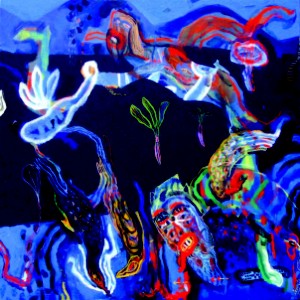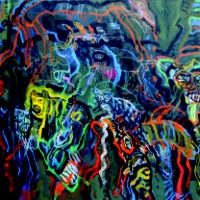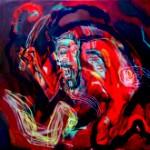| Home - Back Issues - The Team - Contact Us |
 |
| Volume 10 |Issue 23 | June 17, 2011 | |
|
|
Art Do Fine Feathers Make Fine Art? Fayza Haq
Nisar Hossain, a much admired, outspoken professor of the Fine Arts Department at Dhaka University, is never at a loss for words, and speaks with remarkable enthusiasm about the future of artists in Bangladesh. If the art market was the all and end all would Van Gogh have come into existence and the rest of the artists of renown of Russia and Italy who ended in suicide have come into existence? Nisar Hossain says: “Whether in a market form or not–those who worked in the prehistoric period, who could not take part in hunting, who participated in the magic ritual – who were somewhat aging, and happened to be women– they had to establish links with the economy of survival. Those who were bringing home the hunt, believed that they were victorious in the animal hunting game. Thus there was a group of hunters and farmers – while a group recorded their activities by drawing vigorously on the caves. Hence the painter had a vital link with the income-generating group."
“During the feudal days of knights and barons, the artist was a court painter. When the artist got an open market, and the freedom, the painter was rewarded for his personal creativity. Before this, whatever was acceptable by the people was considered the right thing. Today, there is a certain level of people who can appreciate the layers of meaning in an art work. Their talent is recognised. Yet those who have the money in their hand may not be of the intellectual level to be able to truly appreciate the gravity and finesse of the artist's work. If an artist feels that he is going to work in an uncompromised manner that is not possible. The world of art is controlled by the more developed and industrialised world. One cannot say that this is good for world art or that this practice is good universally – considering the Asian, South American and African world. At this moment, one cannot say if the genuinely talented artist is recognised. Even in the case of Van Gogh – there was a certain amount of control by the market and those who paid for his boarding and lodging. One cannot say that Van Gogh's work like the 'Sunflower' is unparalleled. Picasso has said that the Cave paintings of France are unmatched. But the cave paintings are different: That art that can be bought and sold goes up in price; and we think that there is nothing to surpass this. Paintings are commodities that are being promoted for the interest of patrons, and galleries– and not the painters. When there is an investment, it's done in such a manner that it benefits the patron or gallery. When does a patron get hold of an artist? – it is when the artist has reached the signature level – when the signature is recognised and viewers will pay for it. If he does anything highly radical, it is not accepted. Meanwhile, it can never be the goal of the artists to make a world record by the sale of his work. The creative ability of the artist should not be compromised. And this applies to Van Gogh."
What keeps an artist going? Isn't it some sort of reward necessary to keep the artist going even if it is just a medal or prize money or even a bottle of wine or a month's rent for the room? Nisar Hossain says that an artist is a member of the society. He moves with a set group of people. In any work, he needs inspiration. Within a creative practice, the work itself can be inspiration for the artist, the experienced professor says. For instance, when Rabindranath painted, for a long time, people did not appreciate them. He got pleasure just doing his work. Within him, grew a huge demand for appreciation. He went to the west. He decided that he would not take his paintings to his country because the people there did not appreciate these paintings. He decided to give them away. During his life, Rabindranath could not sell any of his work. The appreciation that he received was on a level that Indian painters have not received, as yet. One needs appreciation. Man does not want to do a meaningless work. He is a human being. He wants that what he has painted on his earth should be appreciated. He wants something positive from this–be it just pleasure. An artist feels that a sense of satisfaction is necessary and not just money or appreciation in print. The same applies to music composers or writes. Those who draw and paint say that satisfaction cannot be bought with mere money. Hence painting is just a spiritual practice. Man is a social being. He wants to share what he does with those around him. He also wants to share his emotions like his love, joy and pain. He wants recognition from others.
What should be the aim of a true artist? How far should he try to make his work global i.e. acceptable anywhere in the world–or should he keep to the blue sky, boats and bathing beauties of the village to give the work a local brand? Should the artist not search for something new and something fresh? The well-loved professor says that the term 'true artist' is an overrated term. One cannot standardise a true men or a true artist, he says. An ideal man, a situation, an ideal society is hard to get. These terms suggest too much of expectations. “I feel that through art, literature and music–through the practice of art– we find the various ways a man can see, feel. My personal feelings are not every other man's thoughts and feelings. The thoughts of ten men are not those of a specific person. Each art work, seen by five people, is seen in five different ways. Hence, I feel, it is difficult to say what the true artist is. When I see an artist's work, I'll see the way in which he is seeing at things in a way so different from mine. Thus, when I read someone's work, I'm amazed at the different way the writer is thinking. We can't put our finger on what is good, bad or ideal. One can show a negative situation, while another a positive one. One can show something ugly or something nice,” says the patient professor. Asked about the future of the Bangladeshi artist, Nisar Hossain is firmly positive and optimistic. He points out that fine arts activities in our country are covered more widely in our daily papers, magazines, radio and TV than anywhere else in the subcontinent or the rest of South Asia.
Copyright
(R) thedailystar.net 2011 |



